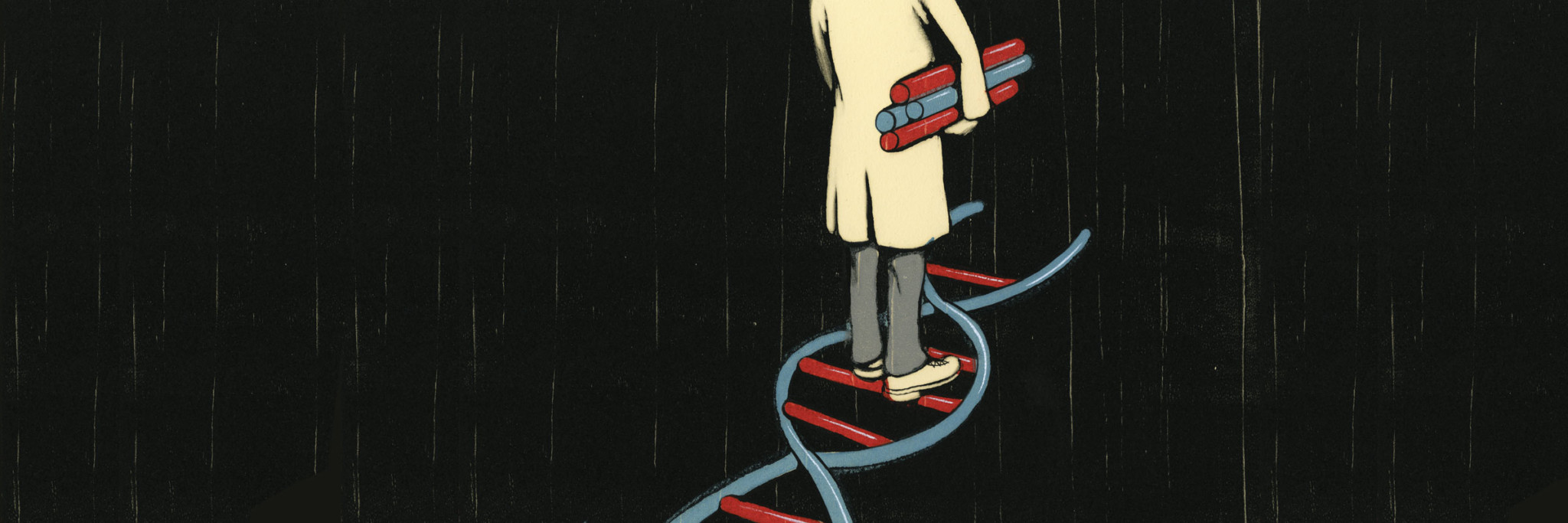In his office, Jeff Thompson keeps a microwave older than some of his students. It dates back to when he first went to graduate school to study molecular biology. “It still seals fairly well,” says Thompson, “and it seems to be safe.” Still, he’s thinking of having it tested soon.
A radiation test for the appliance that heats up his lunch is a fitting precaution for a scientist who specializes in cell damage and DNA repair. Specifically, Thompson looks at histones–proteins within the cell used to package the DNA–which play a role in the repair process of cells damaged by UV rays. It was a subject of study that he “just kind of stumbled into” during graduate school, but researching these packaging proteins has since turned into a 20-year-long career.
Work that he had done in his graduate lab suggested that histones were related to almost anything involving DNA, but Thompson still had unresolved questions when he began running his own lab. So when he came to Denison in 2003, “I was wondering if these histone proteins might be involved in DNA repair processes … the answer that kept coming out time and time again through our experiments was ‘yes.’”
And now he’ll get to dig deeper into the details of what, exactly, the proteins are doing with the help of a nearly $318,000 grant from the National Institutes of Health and supported by the American Recovery and Reinvestment Act. “Are the proteins recruiting repair factors?” he asks. “Are they organizing the DNA in a way that would make it easy for repair to take place? There are lots of different possibilities.”
While Thompson’s hope in the longterm is that histone research might provide scientists with clues for, say, developing new drugs for chemotherapy or preventative cancer treatments–”I’ve always kind of joked that we could come out with a new sunscreen that has a histone additive”–he and the students working in his lab are currently in the primary stage of research: figuring out how histones work on the most basic level.
“The way I’ve always described it in my class,” explains Thompson, “is if you imagine you’re an alien, you come to earth, and you see these cars–you see them moving around, and you know what they do, but you have no idea how they work. What you do, as the alien, is go through the car piece by piece.” You yank wires here and there, randomly testing various components to determine which are critical to functioning and which are less so. “You then take these pieces of information and use them to create a model to explain how the car works. It’s an analogy for what we do in the lab–we introduce random changes to these [histones] just to see what happens.” They then use those observations to predict what role histones play in responding to DNA damage.
Thompson notes that even though the $318,000 is a substantial grant, “it won’t be hard to spend the money.” “It’s really going to allow the lab to do a lot of things that have been very challenging up to this point.” The bulk of it will go toward special supplies and materials as well as three student researchers every summer for three years to assist with research.
“[Research] can become very costly, very fast, so having this money really opens the door,” Thompson explained. “Instead of scrimping and having to figure out which of four experiments I’m going to do–because I can only afford one–now we can do all of them.” This freedom will enable Thompson and his team to move forward quickly over the next couple of years.
Students play a crucial role in Thompson’s research, and he gives them their due credit. “I’ll be continuing to depend upon them in the future … I view them as active members of the research program,” he says. “They’re not just there as a free pair of hands; they’re members of the lab and involved in the scientific process.”
Perched on a shelf in his light and airy office, Thompson keeps a reminder of his students. It looks like a large cotton ball with beige buds forming a ring around its head. It has dark glass eyes. Thompson lifts the stuffed “animal” onto his palm. “This is my little yeast cell,” he says, explaining that his students bought him the “stuffed” version of the real single-celled organism used in their experiments as a gift. Histone proteins are more or less universal, and what the researchers observed in yeast cells would likely be applicable to almost any other species. So even these stuffed cells remind Thompson of the work facing him–except for one little thing: “Obviously,” Thompson says, “yeast cells don’t have eyes.”

